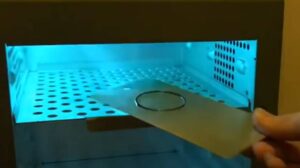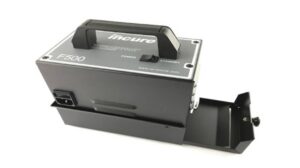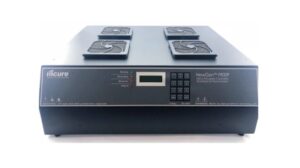What Is a Retaining Compound?
A retaining compound is a specialized anaerobic adhesive used to bond non-threaded cylindrical metal parts into a strong, high-precision assembly. These adhesives cure in the absence of air and in the presence of metal, filling microscopic gaps between close-fitting surfaces to create a solid, vibration-resistant joint.
Unlike traditional press-fit methods, retaining compounds increase surface contact and overall strength by forming a 100% metal-to-metal bond, improving performance in demanding applications.
How Do Retaining Compounds Work?
Retaining compounds work differently than conventional adhesives like super glue, which cure when exposed to moisture. These anaerobic adhesives cure only when confined between two tightly fitting metal surfaces, such as shafts and bearings.
In typical metal assemblies, even precision fits only achieve around 30% surface contact, leaving microscopic gaps. Under high stress or vibration, these gaps allow for micro-movement, leading to:
-
Fretting corrosion: Caused by metal-on-metal wear within the joint.
-
Loosening of parts: Over time, gaps grow and reduce fit integrity.
-
Reduced mechanical strength: Limits the performance of interference or press fits.
By filling these voids, retaining compounds eliminate micro-movement, distribute stress uniformly, and can increase joint strength by up to 3–4 times compared to traditional interference fits.
Common Applications of Retaining Compounds
Retaining compounds are widely used in manufacturing, automotive, aerospace, and industrial machinery to enhance or restore mechanical fits. They’re ideal for:
-
Bearings in housings or on shafts: Prevents spinning and wear during operation.
-
Gears, pulleys, and sprockets: Locks components in place under high torque.
-
Cylinder liners in engine blocks: Provides sealing and stability, especially in engine repairs.
-
Repairing worn metal parts: Fills gaps in damaged shafts or housings, avoiding costly part replacements or machining.
Key Benefits of Using Retaining Compounds
Using retaining compounds offers several performance and cost advantages:
-
Increased load capacity: Bonds components into a unified assembly for better load distribution.
-
Prevents fretting and wear: Eliminates microscopic motion that leads to corrosion.
-
Simplifies assembly: Allows for looser machining tolerances, reducing production costs.
-
Improved durability: Creates a rigid, long-lasting joint resistant to shock and vibration.
How to Choose the Right Retaining Compound
Different applications require different types of retaining compounds, each optimized for specific conditions:
-
High-strength retaining compound: Ideal for permanent assemblies in heavy equipment or industrial applications.
-
Medium-strength: Suitable for assemblies that may require future disassembly with tools.
-
High-temperature resistant: Designed for automotive engines and other high-heat environments.
-
High-viscosity: Best for worn parts or larger gaps needing gap-filling capabilities.
-
Low-viscosity: Perfect for tight-fitting, precision components with minimal clearance.
Optimize your assembly performance with the right retaining compound—whether you’re enhancing a new design or restoring a worn component. For expert advice or product selection, contact us today or explore Incure full line of WeldLock™ retaining adhesives.
| Product | WeldLock™ Highlights | Color | Viscosity (mPa·s) | Strength | Temp. Range | Curing Time |
| WeldLock™ 356 | Retaining Compound (Metallic Grey) High-strength repair compound for worn press fit parts. Ideal for press fit repairs, filling large gaps, and restoring tight fits in shafts, housings, keyways, bearings, and sleeves. |
Metallic Grey | 2500 | High | -50°C to 150°C | 10 mins (initial), 24 hrs (full) |
| WeldLock™ 338 | Retaining Compound (Yellow) Medium strength, easy disassembly for cylindrical assemblies. Designed for press or slip fit applications where future disassembly is required. Ideal for maintenance-friendly bonding of cylindrical metal parts. |
Yellow | 600 | Medium | -50°C to 150°C | 10-30 mins (initial), 24 hrs (full) |
| WeldLock™ 365 | Retaining Compound (Green) High-strength slip fit compound for repair and assembly. Ideal for slip fit assemblies and the refitting of worn cylindrical parts. Offers reliable bonding with fast fixture time and excellent gap-filling capabilities. |
Green | 1250 | High | -50°C to 150°C | 10 mins (initial), 24 hrs (full) |
| WeldLock™ 347 | Retaining Compound (Green) High-strength, fast-curing solution for high-temp press fit applications. Ideal for press fit cylindrical assemblies exposed to elevated temperatures and dynamic loads, such as securing gears, rotors, and shafts. Offers maximum holding power with quick fixture time. |
Green | 550 | High | up to 175°C | 5 mins (initial), 24 hrs (full) |
| WeldLock™ 330 | Retaining Compound (Green) High strength, fast curing for slip fit assemblies. Engineered for high dynamic loads and slip fit applications. Offers exceptional strength (25 N/mm²) and rapid curing performance. Ideal for retaining cylindrical metal parts exposed to vibration, impact, or cyclic loading. |
Green | 2500 | High | -50°C to 150°C | 5 mins (initial), 24 hrs (full) |
| WeldLock™ 309 | Retaining Compound (Green) High strength, low viscosity, metal bonding solution. Secure your metal assemblies with this high-performance, press-fit formula for retaining rigid metal parts. With a low viscosity (125 mPa·s), it penetrates tight-fitting parts easily and offers high shear strength (16 N/mm²) for reliable, long-term performance. |
Green | 125 | High | -50°C to 150°C | 10 mins (initial), 24 hrs (full) |




